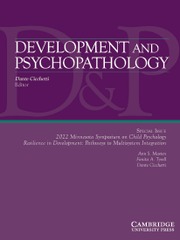No CrossRef data available.
Article contents
Characterizing beneficial change in parent attributions over the course of Parent-Child Interaction Therapy: Dosage in phase of treatment matters
Published online by Cambridge University Press: 22 August 2025
Abstract
Parent attributions about their child significantly impact parenting behavior. The present study investigates parent attributions in the context of Parent–Child Interaction Therapy (PCIT) in child-welfare involved families. PCIT has two treatment phases, the first of which focuses on fostering a warm parent–child relationship and the second of which provides parents a positive discipline framework. This study characterizes individual differences in stability and change in parent attributions over the course of the intervention. It explores the impact of family treatment dosage on parent attributions as well as the impact of parent attributions on positive parenting skills outcomes. In a sample of 149 families involved with the child-welfare system (children aged 3–7, 59% nonwhite, 11% Hispanic, 50% female), multinomial logistic regression analyses and ANCOVAs were used. Results showed that engaging in additional treatment sessions increased the odds of parent attributions about their child increasing in warmth. Additionally, parents whose positive attributions of their child increased over time used more positive parenting behaviors in a cleanup task at posttreatment. These findings demonstrate that parent attributions about their child play an important role in behavioral parent training interventions. Future research should investigate how to leverage parent attributions to improve family treatment outcomes.
Keywords
Information
- Type
- Regular Article
- Information
- Copyright
- © The Author(s), 2025. Published by Cambridge University Press


